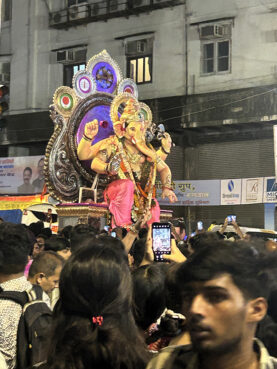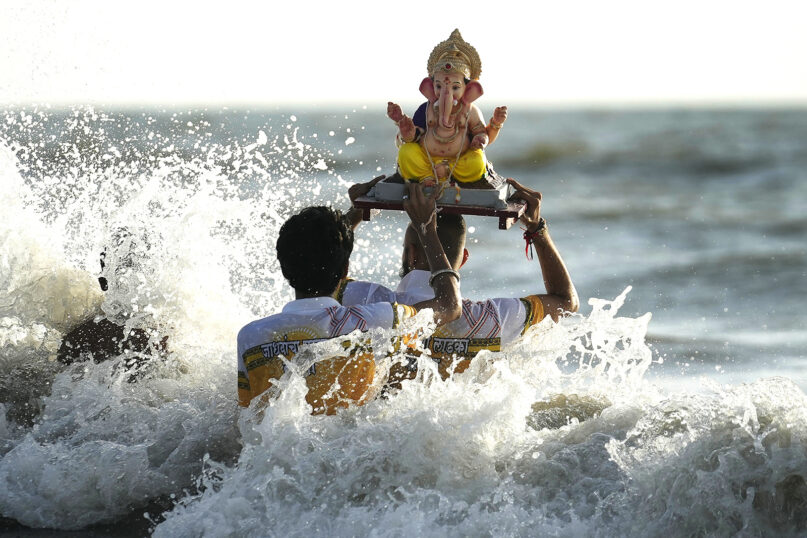(RNS) — Outside my fourth-floor window, the sounds of devotional chanting, lively music and drum beats echoed in the narrow street below. It was Ganesh Chaturthi, a 10-day Hindu festival that earlier this month celebrated the birth of Ganesha, the beloved elephant-headed god known as the remover of obstacles. As a second-generation Indian American Hindu, this was the first time I had the opportunity to immerse myself in this celebration in India.
Statues of Ganesha were on display throughout the neighborhoods and markets of Mumbai, each one a unique masterpiece of artistic expression — some only a foot or two tall, while others towered above me when I walked by. As the festival began, families and neighbors gathered to perform the ceremonial puja, offering prayers, flowers and sweets to the vividly decorated statues that take center stage in their homes and in the neighborhood. By the second day of the festival, families and neighbors carried Ganeshas in the back of their SUVs and hatchback cars, on vegetable carts and parade floats adorned with flowers, heading toward the sea.
The festival is a time of spiritual renewal. The culmination of Ganesh Chaturthi is the “visarjan” of Ganesha — the immersion of all those statues in natural waters, symbolizing the impermanence of life as Ganesha returns to his heavenly abode.
This year, it’s not just Ganesha who’s immersed. It’s me, too. As a member of the global Hindu diaspora, this is the first September I’ve ever spent in India — a blessing owed to my academic sabbatical. To come to a place where the practice of my faith is ubiquitous is an unfamiliar immersion.

A statue of Ganesha in Chowpatty, Mumbai, India. (Photo by Khyati Joshi)
On the last day of visarjan, I experienced the ritual in a private home with family and friends, where the murti (statue) of Ganesha was immersed in a tub of water. It was a mesmerizing sight, watching the environmentally friendly papier-mâché Ganesha slowly sink into the water and dissolve away.
For 10 days, the family had lovingly cared for the statue, proudly displaying it in their home as a revered presence. As the visarjan ritual approached, a bittersweet sense of sadness filled the air. They knew that Ganesh’s time with them was coming to an end.
Then later on, with one of my cousins, I ventured out to the streets, joining the thousands of others also experiencing the visarjan ritual but in the collective space. We watched in awe as the procession of Ganesha statues, both small and large, were being carried and pushed on elaborate floats toward the sea. The energy was palpable, with thousands of people exuding pride and devotion — chanting, dancing and praying fervently as the beloved Ganesha departed.
Though on familiar streets, I found myself immersed in an entirely unfamiliar scene.
As a second-generation Indian American Hindu, worship is something separate from the rest of life. Hindu practice means going to a particular space — the temple in my town, or the altar I keep in my home — then returning to the space of “real life” where my faith is invisible. Even the few open-air worship spaces created during Ganesh Chaturthi, like Jersey City’s pandal (pavilion) with its 8-foot-tall Ganesh, are destinations that must be sought out.
Of course, this is by no means a uniquely Hindu experience. In the United States, boundaries between sacred and everyday spaces are well-defined. But in India during Hindu festivals, religion comes to you — to every street corner, apartment complex and local market. This immersion is seamless, and it feels good. It is a warm soak in the familiar everywhere I go.
It was striking to see how Ganesh Chaturthi transforms the urban landscape: Ganesha shrines and temporary pandals emerge in every nook and cranny. Whether on Napean Sea Road or in Crawford Market, a sense of sacred space seemed to cover the entire bustling city of 22 million people.

An artist naps during a break from crafting statues of the elephant-headed Hindu god Ganesha inside a workshop ahead of Ganesh Chaturthi festival in Mumbai, India, Wednesday, Sept. 4, 2024. (AP Photo/Rafiq Maqbool)
Unlike in the U.S., where a holiday’s importance is conveyed by making it a “day off,” this festival co-exists with the ordinary. I can come upon a sacred space, do darshan, bow my head, say a prayer and then go on about my day. At no point is it intrusive or aggressive, as religion can feel in the U.S. when it is forced into public spaces or secular dialogues.
In my scholarship, I write about “lived religion” — the way our faith emerges and is found in our day-to-day life, not in worship or dogma but in the ways we interact with the world and one another. Experiencing a festival so familiar, in a setting so different, is extraordinary.
After seeing and feeling the spiritual commitment during the visarjan I realized that visarjan is not just a mere immersion of a murti, but a powerful symbolic act that represents the cyclical nature of life and the impermanence of material existence. As the Ganesha murti dissolves into the waters, it reminds us that all things, even the divine, are temporary — a powerful lesson on the transience of life and the importance of cherishing each moment.
As was chanted throughout the festival, seeking help from Ganesha, “Ganpati Bappa Morya.”





